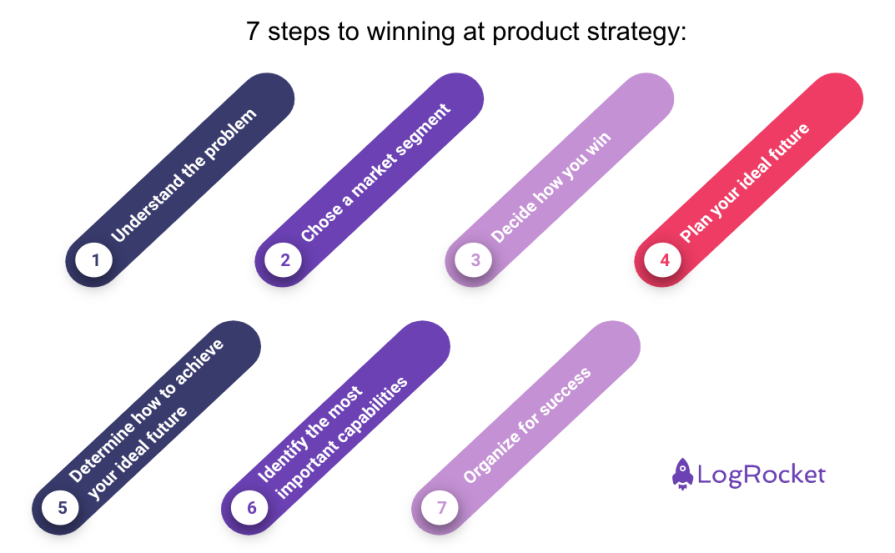When it comes to product strategy, everyone has an opinion. Hundreds of books and articles discuss its importance and how to approach it and yet they often seem to do more harm than good.

With so many conflicting sources of information, beliefs, and frameworks, it can be difficult to grasp how to actually implement a sound product strategy. So, instead of describing my thought process, principles, and beliefs, let me share my step-by-step process for winning at product strategy.
It won’t be perfect for all contexts, but it serves as a good starting point for most product managers:

1. Understand the problem
Products should always start from a user problem. Your success depends upon your ability to deliver value by solving the right problems.
To do this, you need to understand the problem space in painstaking detail. Determine where the problem happens, who it affects, how often it occurs, what alternatives exist, how people recover from the problem, and so on.
2. Choose a market segment
After you understand the problem, choose a market segment to target the problem for. However, beware of the two most common pitfalls: choosing too broad of segments or not choosing them at all.
If you choose too broad of a segment (or too many segments), your target audience will be too diverse to develop a strategy for. To be effective, a strategy must be focused, and for a strategy to be focused, the target segment must be very specific.
Niche down to find a small segment of users that you can truly win at your given stage. If you are a multi-million dollar company, you might have the resources to win big, difficult-to-enter segments. Whereas if you’re a startup, an extremely focused, thousand-people big segment might be good enough.
You can always expand to a new segment once you win the initial one. If you discover that the chosen segment doesn’t work for you, you can always pivot, but even pivoting is easier when you work with small niche segments.
A good market segment should be:
- Homogenous — People in the segment should react similarly to the product, price, messaging, etc.
- Self-referencing — Within the segment, customers should refer products and services to each other
- Targetable — You need to be able to can new or existing growth channels to reach this audience
- Winnable — Without a dominant market player, you can actually become the number one choice for the audience
3. Decide how you win
After the first two steps, you need to set your strategy for winning the market.
Although that might sound complex, in reality, there are only two main ways to win in a given market: cost leadership and differentiation.
Cost leadership
With some markets, you can simply win by being cheaper than the alternative solutions.
This option is usually reserved for big players with a distribution or manufacturing advantage. For example, you might have:
- An exclusive deal with some manufacturer
- A strong distribution channel, keeping your customer acquisition costs minimal
- Breakthrough innovation, allowing you to keep cost-to-serve extremely low
If you can solve a meaningful problem for a well-defined segment at a lower price than competitors, you can become the default option.
Differentiation
Besides cost, you can also win through differentiation. Here’s where niche segmentation comes in. The smaller the segment you target, the more custom-made solutions you can create.
For example, although you might have a little chance of becoming the best CRM platform in the world, you do have a shot of becoming the number one CRM for psychiatrists clinics in the EU. With lower competition and specific segments, you can focus on features and solutions that’ll make your product the best option for that particular use case.
4. Plan your ideal future
With a defined audience, a specific problem, and a high-level plan to win, it’s time to get ambitious.
Imagine your ideal feature. Say that you nailed it, and your product is the best in the world.
What does the user journey look like? When do users come to you? What problem do they solve? What solutions do they get? How do you make money in the process?
It’s similar to defining a product vision, although a bit more grounded. Remember the target audience and the exact problem you’re solving. Don’t get so visionary as to detach from those fundamentals.
But also don’t get scared of being ambitious. You must play to win. The bar must be high enough to push and motivate you.
5. Determine how to achieve your ideal feature
Now that you have a picture of your ideal feature, work backward to identify how to get there.
What are the biggest steps you must take to make the vision a reality? Mark them down. These are your key initiatives.
Plan a roadmap out of those initiatives. Which one do you believe the most? Which ones are most pressing? Plan a rough list of priorities.
Then, work on key assumptions and hypotheses around those hypotheses. I recommend assumption mapping or opportunity solution trees to break down those initiatives into more tangible steps.
6. Identify the most important capabilities
You’ll need to pivot a lot throughout the product development lifecycle. After all, no plan survives first contact with the enemy. But the capabilities usually remain the same.
By capabilities, I mean the critical investments that enable your roadmap.
Look at your ideal future and the steps to achieve it, and ask yourself what key strengths and enablers you need to possess to achieve it.
Is it SEO positioning? A robust virality engine? Maybe you need a custom LMM to enable half of the steps? Perhaps you won’t realize any key initiatives without high-speed cloud architecture.
Another way to ask this question is, “If we pivot the game plan tomorrow, what needs remain relevant?”
By focusing your efforts on enabling capabilities, you can build a moat without sacrificing much-needed agility.
7. Organize for success
Your organization’s structure, habits, and processes should enable the execution and development of the strategy.
A good starting point consists of these four elements:
- Guiding principles — Develop a set of high-level principles that’ll help people make decisions aligned with the strategy. For example, if you run an e-commerce business and believe that the seller comes first, a guiding principle could be “we always prioritize sellers’ needs over buyers’ needs.” This simplifies the strategy and keeps everyone aligned on what tradeoffs to make
- Review system — Strategy is just an assumption. You need to validate it over time with research and experiments. The competition and your target audience also changes over time and will impact your strategy. Make sure you have rituals in place (for example, quarterly review) to review your strategy and ensure it’s still relevant
- Communication system — Strategy only works if it’s always in the back of people’s minds, so you need systems to regularly remind employees of key parts of the strategy. These can be regular strategy-focused company meetings, mentioning how recent releases tie to strategy in a newsletter, or making it part of everyone’s one-on-one agenda
- Measurement system — How do you know if you’re on track with your strategy? How do you know if what you do aligns with what’s most important? You need a system to measure your progress towards strategic objectives so you can track and realign if needed
Closing thoughts
You can use whatever frameworks you want, but no matter what angle you look at product strategy from, you still need to know the following basics:
- The problem
- The audience
- The strategic vision
- The plan to realize the vision
- The capabilities to enable the plan
- The systems to keep the strategy in place
Ensure you nail these, and then use whatever approach you want to develop your strategy further.
However, in my experience — the simpler, the better.
Featured image source: IconScout